The GetDPI Photography Forum
Great to see you here. Join our insightful photographic forum today and start tapping into a huge wealth of photographic knowledge. Completing our simple registration process will allow you to gain access to exclusive content, add your own topics and posts, share your work and connect with other members through your own private inbox! And don’t forget to say hi!
Use IR filter or not for B&W only
- Thread starter Mikec
- Start date
Stuart Richardson
Active member
Yes, you can certainly shoot it in black and white, but keep in mind that it will not look quite the same. Think of it as shooting an infrared film without a visible light blocking filter. Or at least a black and white film that exposes into the infrared spectrum (SFX would be a good analog). You won't get any highlight bloom like HIE, but it will lift the exposure in certain things without clear warning. So some foliage will look brighter than it does to the eye, and the black synthetic fabrics which would turn magenta without the IR filter will look brighter. So a jacket that looks black to the eye will look light grey in your black and white conversion. Under tungsten lighting this effect will be amplified. The ruddy and magenta tinged complexions you get without the IR filter will look like you were shooting with a magenta filter in black and white. In fact, if you can't find M8 files taken without filters, you can open up a regular file in photoshop and use the photo filter layer tool to give it a magenta cast. Then convert it to black and white. Then you can turn on and off the magenta filter, and see the effect. It is not quite the same, but it gives you a bit of a feel.
K
kipkeston
Guest
I would try both ways yourself. I prefer IR actually I think it has deeper and richer blacks. I convert with gradient map in PS.
Stuart Richardson
Active member
Ok, here is an example so you can see what is going on...at least if you were to take a picture of yourself in my bathroom, which I am not sure I would be comfortable with. The lighting is mostly halogen.
Both photos have the exact same white balance, plus .5ev and +1 black clipping in ACR. I then took those two photos and converted them to black and white by converting them to LAB and using the luminance channel (this should eliminate any influence of the channel mixer).
None of the photos have been optimized, this is just out of the camera other than what I mentioned. You can see that the M8 has a bit of an IR problem! I picked one up at photo plus when it was released and the first photo I took, I was immediately like, excuse me? I am absolutely astonished that they did not think people would notice (and care) about this. They obviously have (had?) some serious issues with understanding their market.
Anyway, the images. The jacket should be black, along with the bag. They are two different synthetic materials. The sweater should be brown. I should be white.
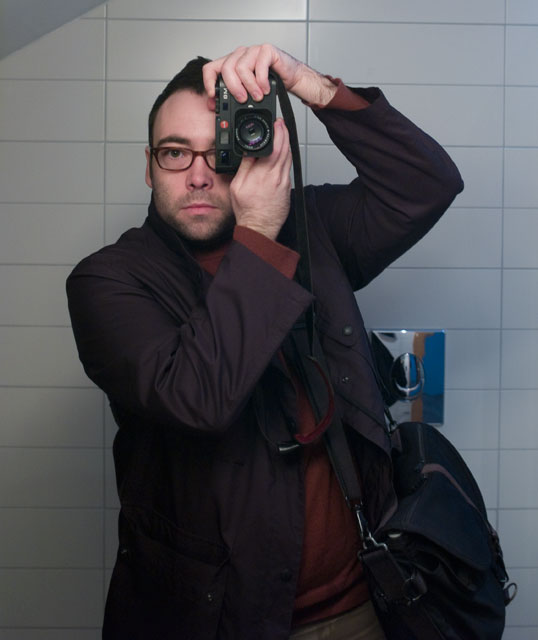
with filter
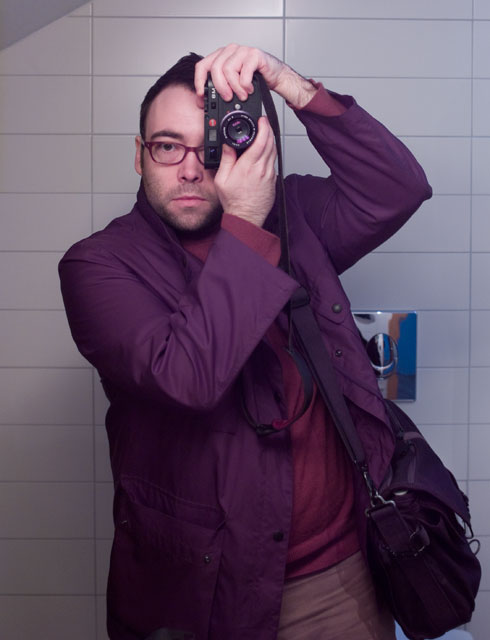
without filter
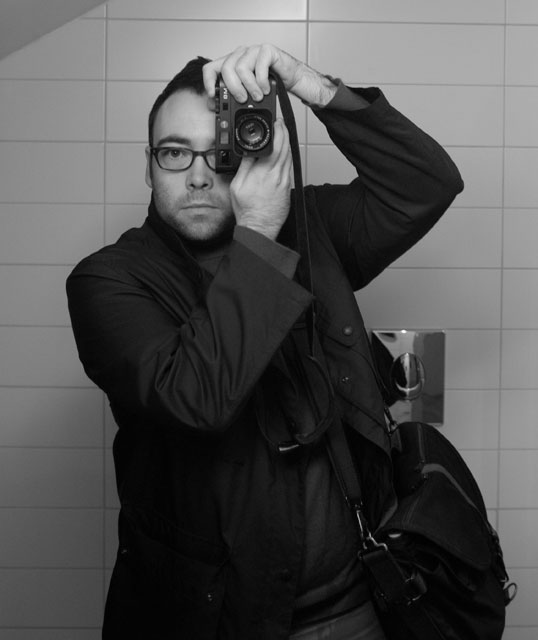
Black and white with filter
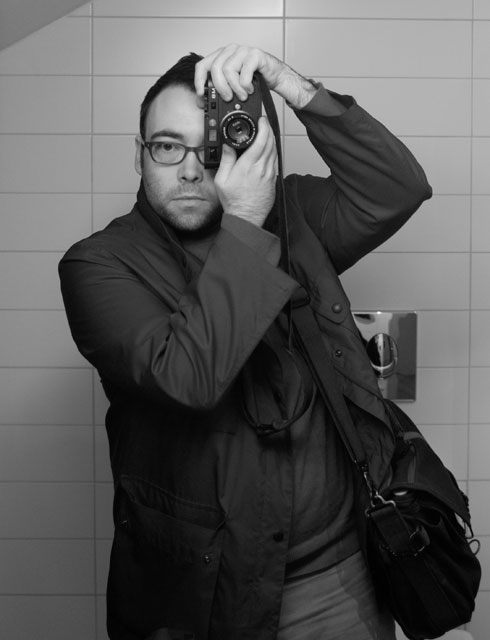
Black and white without filter.
In this case, I prefer the photo without the filter, but as Erik mentioned, I would rather have the option to have it either color or black and white, so I almost always leave the filters on unless I have to shoot with bright light sources in the frame. The other issue is that while sometimes it may look better without the filter, it is generally unpredictable -- it can do weird things with the tonality and with complexions.
Both photos have the exact same white balance, plus .5ev and +1 black clipping in ACR. I then took those two photos and converted them to black and white by converting them to LAB and using the luminance channel (this should eliminate any influence of the channel mixer).
None of the photos have been optimized, this is just out of the camera other than what I mentioned. You can see that the M8 has a bit of an IR problem! I picked one up at photo plus when it was released and the first photo I took, I was immediately like, excuse me? I am absolutely astonished that they did not think people would notice (and care) about this. They obviously have (had?) some serious issues with understanding their market.
Anyway, the images. The jacket should be black, along with the bag. They are two different synthetic materials. The sweater should be brown. I should be white.

with filter

without filter

Black and white with filter

Black and white without filter.
In this case, I prefer the photo without the filter, but as Erik mentioned, I would rather have the option to have it either color or black and white, so I almost always leave the filters on unless I have to shoot with bright light sources in the frame. The other issue is that while sometimes it may look better without the filter, it is generally unpredictable -- it can do weird things with the tonality and with complexions.
I usually prefer without. To my eye, it renders the overall tonal ranges a bit more accurately. Perhaps more importantly, it also usually heightens shadow detail. However, for people, shooting without the IR cut filter also lightens skin tonality, which may not be desirable in certain situations.
Erik Five
Member
You could back Prince up in purple rain with that second shotOk, here is an example so you can see what is going on...at least if you were to take a picture of yourself in my bathroom, which I am not sure I would be comfortable with. The lighting is mostly halogen.
Both photos have the exact same white balance, plus .5ev and +1 black clipping in ACR. I then took those two photos and converted them to black and white by converting them to LAB and using the luminance channel (this should eliminate any influence of the channel mixer).
None of the photos have been optimized, this is just out of the camera other than what I mentioned. You can see that the M8 has a bit of an IR problem! I picked one up at photo plus when it was released and the first photo I took, I was immediately like, excuse me? I am absolutely astonished that they did not think people would notice (and care) about this. They obviously have (had?) some serious issues with understanding their market.
Anyway, the images. The jacket should be black, along with the bag. They are two different synthetic materials. The sweater should be brown. I should be white.

with filter

without filter

Black and white with filter

Black and white without filter.
In this case, I prefer the photo without the filter, but as Erik mentioned, I would rather have the option to have it either color or black and white, so I almost always leave the filters on unless I have to shoot with bright light sources in the frame. The other issue is that while sometimes it may look better without the filter, it is generally unpredictable -- it can do weird things with the tonality and with complexions.
E
edwinb
Guest
the focus shifts as you move up the spectrum from uv -b -g -r to ir so if you narrow the range of spectrum captured and had some point iin sharp focus I would expect it to become sharper if the subject refects evenly through the spectrum.
edwin
edwin
Hmmm...
I am trying to decide which set of disadvantages to accept.
With IR filter
- Very slightly lower contrast (probably only a "theoretical" difference)
- Potential trouble with bright light sources causing reflections
Without IR filter
- Color file would require a lot of work (I am ok with B&W only)
- Focus shift
What else am I missing?
I am trying to decide which set of disadvantages to accept.
With IR filter
- Very slightly lower contrast (probably only a "theoretical" difference)
- Potential trouble with bright light sources causing reflections
Without IR filter
- Color file would require a lot of work (I am ok with B&W only)
- Focus shift
What else am I missing?
jonoslack
Active member
Hi Stuart
What an excellent comparison - I'm not sure that I've seen anything quite as dramatic as that shot without a filter!
With Filter
-Lower contrast - I think that this is likely to be an advantage slightly more often than it's a disadvantage (especially if you're using the modern lenses) - but as you say, theoretical
- Light reflections; I've certainly never noticed these - of course, there must be some impact of using a filter, but it's not something that's ever impinged on me.
Without filter
- Colour file - it requires more than a lot of work - in my experience it's just impossible to get it right if you have noticeable pollution. The worst is skin tones in artificial light, veins show up and you really can't do anything about it. Greens in springtime are another disaster area.
- Focus shift - I must say, I never noticed this.
I should clarify, for the first 6 months I used the M8 without filters, mostly it was fine, and then you'd get a batch of shots which were basically unrecoverable; I had a shoot of a garden in Cornwall taken in early spring with huge Gonera just sprouting - they were either black and white or not useable.
The other point is that, having bitten the bullet, you simply bung the filters on everything, set the camera on UV/lens detection ON and forget it.
Trying to mix and match caused me a lot of disasters (i.e. shots with no filter and UV/lD on etc.
Since I bit the bullet 18 months ago, I have simply not given it another thought. My Black and white stuff makes me happy, and so does the colour.
An added bonus is that when you're using very very expensive lenses, it's quite nice to have something protecting the front element (I have one scuffed IR filter already).
What an excellent comparison - I'm not sure that I've seen anything quite as dramatic as that shot without a filter!
HI MikeHmmm...
I am trying to decide which set of disadvantages to accept.
With IR filter
- Very slightly lower contrast (probably only a "theoretical" difference)
- Potential trouble with bright light sources causing reflections
Without IR filter
- Color file would require a lot of work (I am ok with B&W only)
- Focus shift
What else am I missing?
With Filter
-Lower contrast - I think that this is likely to be an advantage slightly more often than it's a disadvantage (especially if you're using the modern lenses) - but as you say, theoretical
- Light reflections; I've certainly never noticed these - of course, there must be some impact of using a filter, but it's not something that's ever impinged on me.
Without filter
- Colour file - it requires more than a lot of work - in my experience it's just impossible to get it right if you have noticeable pollution. The worst is skin tones in artificial light, veins show up and you really can't do anything about it. Greens in springtime are another disaster area.
- Focus shift - I must say, I never noticed this.
I should clarify, for the first 6 months I used the M8 without filters, mostly it was fine, and then you'd get a batch of shots which were basically unrecoverable; I had a shoot of a garden in Cornwall taken in early spring with huge Gonera just sprouting - they were either black and white or not useable.
The other point is that, having bitten the bullet, you simply bung the filters on everything, set the camera on UV/lens detection ON and forget it.
Trying to mix and match caused me a lot of disasters (i.e. shots with no filter and UV/lD on etc.
Since I bit the bullet 18 months ago, I have simply not given it another thought. My Black and white stuff makes me happy, and so does the colour.
An added bonus is that when you're using very very expensive lenses, it's quite nice to have something protecting the front element (I have one scuffed IR filter already).
Stuart Richardson
Active member
To be honest, I hate the IR filters (and filters of any kind) and since they are not multicoated (they cannot receive multicoating as well as the IR coating), they are very prone to reflections. I don't know if it is just my camera, but every time I have a bright light source in the frame in an otherwise dark shot, I get them...in spades.
Here is my most obvious example:

The ufo's at the bottom there are from the filters.
This is another example -- if you look in the graffiti area at left, you can see the reflections from the headlights and street lights at right.
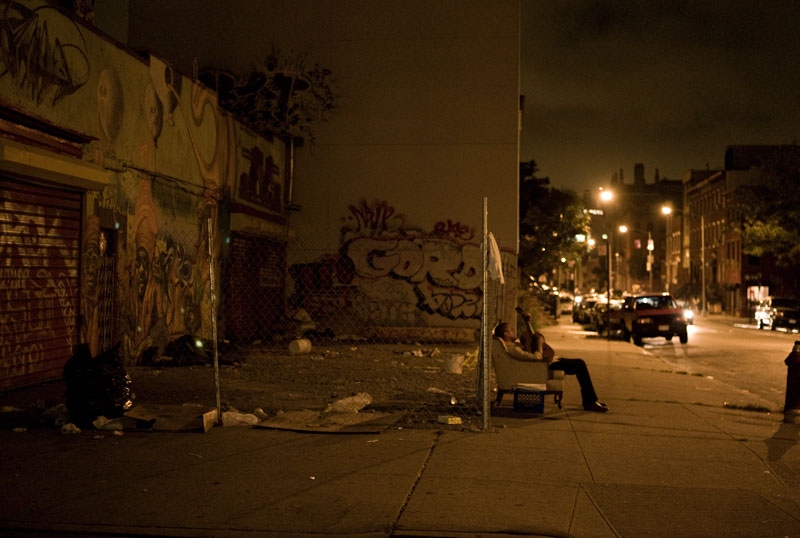
The last time I had it happen, I was photographing a musician at a bar, and there were some candles behind him that caused UFO's in the head of one of the people in the audience.
Overall, they should just put a damn IR filter on the sensor like every other camera. I know it is a technical issue due to the film to flange distance being close and the off-axis light, but it is surely not an insurmountable technical problem. We've landed men on the moon after all...this can't be that hard.
Anyway, the example I posted above IS obvious, but I am exaggerating it -- under halogen lighting wearing a synthetic jacket. I used the same white balance as the IR filtered shot, but I could surely tweak it a bit to make it look less magenta, but as Jono said, these files are fundamentally uncorrectable. The IR reflection does not act evenly on all materials, so there is no way to correct for it without throwing everything else out of whack.
So my basic pattern is always use the IR filters except when photographing at night.
Here is my most obvious example:

The ufo's at the bottom there are from the filters.
This is another example -- if you look in the graffiti area at left, you can see the reflections from the headlights and street lights at right.

The last time I had it happen, I was photographing a musician at a bar, and there were some candles behind him that caused UFO's in the head of one of the people in the audience.
Overall, they should just put a damn IR filter on the sensor like every other camera. I know it is a technical issue due to the film to flange distance being close and the off-axis light, but it is surely not an insurmountable technical problem. We've landed men on the moon after all...this can't be that hard.
Anyway, the example I posted above IS obvious, but I am exaggerating it -- under halogen lighting wearing a synthetic jacket. I used the same white balance as the IR filtered shot, but I could surely tweak it a bit to make it look less magenta, but as Jono said, these files are fundamentally uncorrectable. The IR reflection does not act evenly on all materials, so there is no way to correct for it without throwing everything else out of whack.
So my basic pattern is always use the IR filters except when photographing at night.
jonoslack
Active member
Nasty Nasty . . . but easier to clone out than nasty veins in faces (of course, being a spring chicken you won't care how oldies look, but we 50 somethings are desperately vain:ROTFL:The last time I had it happen, I was photographing a musician at a bar, and there were some candles behind him that caused UFO's in the head of one of the people in the audience.
Having worked beta testing Kodak firmware for the 14n and SLR/n, and their 'Italian Flag' problems with different lenses, I wonder if you're right about this - there may be a way around it, but for a camera where you aren't able to know which lens is attached I think it could be a pretty fundamental problem. The Kodak problem was partly cured in firmware, but it was only because you knew which lens you had attached, and you needed a different correction for each lens.Overall, they should just put a damn IR filter on the sensor like every other camera. I know it is a technical issue due to the film to flange distance being close and the off-axis light, but it is surely not an insurmountable technical problem. We've landed men on the moon after all...this can't be that hard.
Sounds reasonable, of course, being young and smart, you won't make those nasty mistakes (taking off the filter and forgetting to change the menu . . . putting it on and forgetting to change it back!).Anyway, the example I posted above IS obvious, but I am exaggerating it -- under halogen lighting wearing a synthetic jacket. I used the same white balance as the IR filtered shot, but I could surely tweak it a bit to make it look less magenta, but as Jono said, these files are fundamentally uncorrectable. The IR reflection does not act evenly on all materials, so there is no way to correct for it without throwing everything else out of whack.
So my basic pattern is always use the IR filters except when photographing at night.
Stuart Richardson
Active member
Yes. There is off, lens detection on (just does Exif and vignetting), and lens detection plus UV/IR which also corrects for the cyan vignetting.
You can get into trouble if you leave the last one on without the filter, because it will try to correct cyan corners that are not there, making them red. Again, this is something that could be easily fixed by Leica letting you apply the correction to the RAW file (something like the picture controls on Nikon) or even in Capture One. But no. Lens coding is not selectable either -- it's either you remember to do it in camera, or you are stuck doing it on your own.
You can get into trouble if you leave the last one on without the filter, because it will try to correct cyan corners that are not there, making them red. Again, this is something that could be easily fixed by Leica letting you apply the correction to the RAW file (something like the picture controls on Nikon) or even in Capture One. But no. Lens coding is not selectable either -- it's either you remember to do it in camera, or you are stuck doing it on your own.
Peter Klein
New member
Except for the flare issue, I think it's almost always better to use IR filters even in B&W. There is a loss of both sharpness and contrast when you don't use them. See the attached side-by-side comparison. It's in tungsten light, which is very IR-rich, and the blurring effect is quite noticeable. You can question my focusing in these handheld shots, but I've gotten the same slight blurring in other unfiltered shots, too.
On the other hand, you might gain enough opening of the shadows, or maybe a half-stop of shutter speed if you don't use the filter in really dim artificial light. That might be more important than what you lose.
Pick your poison...
--Peter
On the other hand, you might gain enough opening of the shadows, or maybe a half-stop of shutter speed if you don't use the filter in really dim artificial light. That might be more important than what you lose.
Pick your poison...
--Peter
Last edited:
